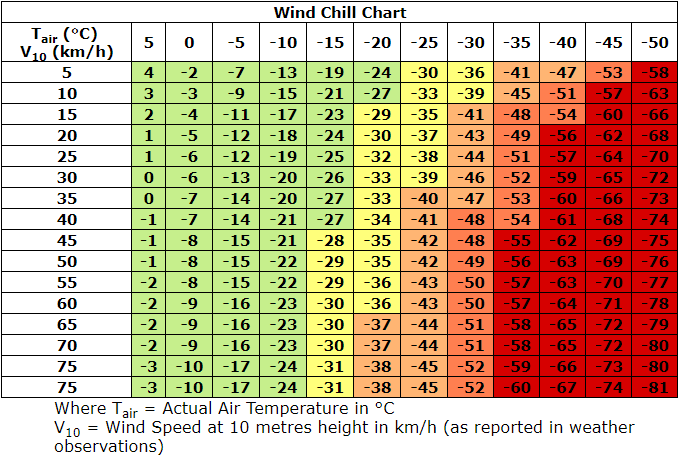We are often asked what maximum wind speed a rope access tech can work at. Of course there is no quick answer.
Wind can be deceiving because you cannot tell if it is windy at height. Beside a freak wind where a tech can be taken by surprise there is another important element to consider: the wind chill factor. Overall the influence of wind is an important factor when working at height.
Determining if you can work on rope depends on:
- The project / industry
Towers are bound to guidelines - Who you depend on
If you need a crane for hauling or a boat for rescue by-stand, they have limits - How high you are working
Height has a definite influence - What you are doing
If you are spray painting you most likely don’t want too much wind - Level of protection
Can you work on the lee side or in a void. Wear goggles, ear plugs, wind proof clothing, etc - Wind factor vs. cold
The Defence R&D Canada is world renowned for its research in influences of cold temperature on humans. The results are amazing and the wind chill factor is a definite enemy when you are working at height due to the fact you are getting more exposed to higher wind speeds.
It almost seems impossible to determine at what wind speed you can work with so many influences. It is safe to say that when a crane operator can’t work the rope access technician can’t do their work when they need the crane.
There are no set standards and since the rope access tech can hang safely it is important to realise that other factors will weight more heavily in the decision then technician on rope, such as:
- A) Possibility to tie the ropes off so the technician isn’t picked up by the wind and swept off his or her feet?
- B) Can tools be safely used without flying all over the place?
In short you can create a safe workplace if you take everything into account. From our experience the average cut off limit is 35km/h – 10m/s. Keep in mind that it depends on what you are doing.
One of the many factors we also shouldn’t forget the wind chill factor especially in the winter when wind can cause the feeling of extreme low temperatures. Simply said hands / fingers get numb due to the cold and you need them to be able to operate the ropes…
To determine if you can work or not we now know that there are many factors and we should keep a eye out on temperature and with whom we are working. So if we say we can work in ideal conditions up to 35km/h winds. The second thing to look at is the temperature, which gives us a -27°C as temperature we can still perform as long as we dress ourselves properly.
Below there are two tables the first is from Environment Canada on wind chill temperatures vs speed and the second one is a table that translates the different ways we often use to describe the wind speed.
For more information on influences on wind chill factors have a look at the Environment Canada web site.

Notes
- For a given combination of temperature and wind speed, the wind chill index corresponds roughly to the temperature that one would feel in a very light wind. For example, a temperature of -25°C and a wind speed of 20 km/h give a wind chill index of -37. This means that, with a wind of 20 km/h and a temperature of -25°C, one would feel as if it were -37°C in a very light wind.
- Wind chill does not affect objects and does not lower the actual temperature. It only describe how a human being would feel in the wind at the ambient temperature.
- The wind chill index does not take into account the effect of sunshine. Bright sunshine may reduce the effect of wind chill (make it feel warmer) by 6 to 10 units.
- Source Environment Canada



